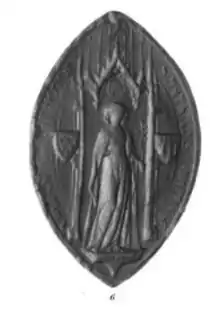Mahaut of Châtillon
Mahaut of Châtillon (1293– 3 October 1358) was the daughter of Guy IV of Châtillon and Marie of Brittany.
Mahaut of Châtillon | |
|---|---|
 | |
| Born | 1293 |
| Died | 3 October 1358 |
| Noble family | Châtillon |
| Spouse(s) | |
Issue
| |
| Father | Guy III of Châtillon |
| Mother | Marie of Brittany |
Marriage
In 1308 she married Charles of Valois,[1] the son of Philip III of France and Isabella of Aragon. He was also the brother of Philip IV of France. Charles himself had married twice before; upon the death of his second wife Catherine I of Courtenay in 1308, he married Mahaut. Mahaut and Charles had four children. One of their daughters would make them ancestors of French Kings, and another daughter would become Queen of Germany.
Mahaut and Charles's children were:
- Marie of Valois (1309–1332). Married Charles, Duke of Calabria and had issue.
- Isabella of Valois (1313 – August 26, 1388). She married Peter I, Duke of Bourbon. Had issue
- Blanche of Valois (1317–1348). She married Charles IV, Holy Roman Emperor. Sometimes called "Marguerite". Had issue
- Louis, Count of Chartres (1318–1328). Died young, no issue
Her husband Charles died in 1325. Mahaut died 33 years later in 1358 at the age of 65, having outlived three of her four children; only her daughter Isabella outlived her.
Ancestors
| Ancestors of Mahaut of Châtillon | |||||||||||||||||||||||||||||||||||||||||||||||||||||||||||||||||||||||||||||||||||||||||||||||||||||||||||||||||||||||||||||||||||||||||||||||||||||||||||||||||||||||||||||||||||||||||||||||||||||||||||||||||||||||||||||||||||||||||||||||||||||||||||||||||||||||||||||||||||||||||
|---|---|---|---|---|---|---|---|---|---|---|---|---|---|---|---|---|---|---|---|---|---|---|---|---|---|---|---|---|---|---|---|---|---|---|---|---|---|---|---|---|---|---|---|---|---|---|---|---|---|---|---|---|---|---|---|---|---|---|---|---|---|---|---|---|---|---|---|---|---|---|---|---|---|---|---|---|---|---|---|---|---|---|---|---|---|---|---|---|---|---|---|---|---|---|---|---|---|---|---|---|---|---|---|---|---|---|---|---|---|---|---|---|---|---|---|---|---|---|---|---|---|---|---|---|---|---|---|---|---|---|---|---|---|---|---|---|---|---|---|---|---|---|---|---|---|---|---|---|---|---|---|---|---|---|---|---|---|---|---|---|---|---|---|---|---|---|---|---|---|---|---|---|---|---|---|---|---|---|---|---|---|---|---|---|---|---|---|---|---|---|---|---|---|---|---|---|---|---|---|---|---|---|---|---|---|---|---|---|---|---|---|---|---|---|---|---|---|---|---|---|---|---|---|---|---|---|---|---|---|---|---|---|---|---|---|---|---|---|---|---|---|---|---|---|---|---|---|---|---|---|---|---|---|---|---|---|---|---|---|---|---|---|---|---|---|---|---|---|---|---|---|---|---|---|---|---|---|---|---|---|---|
| |||||||||||||||||||||||||||||||||||||||||||||||||||||||||||||||||||||||||||||||||||||||||||||||||||||||||||||||||||||||||||||||||||||||||||||||||||||||||||||||||||||||||||||||||||||||||||||||||||||||||||||||||||||||||||||||||||||||||||||||||||||||||||||||||||||||||||||||||||||||||
References
- The Cultural Context of the French Prose "remaniement" of the Life of Edward the Confessor by a nun of Barking Abbey, Delbert W. Russell, Language and Culture in Medieval Britain: The French of England, C.1100-c.1500, ed. Jocelyn Wogan-Browne, (Boydell & Brewer, 2013), 299.
This article is issued from Wikipedia. The text is licensed under Creative Commons - Attribution - Sharealike. Additional terms may apply for the media files.